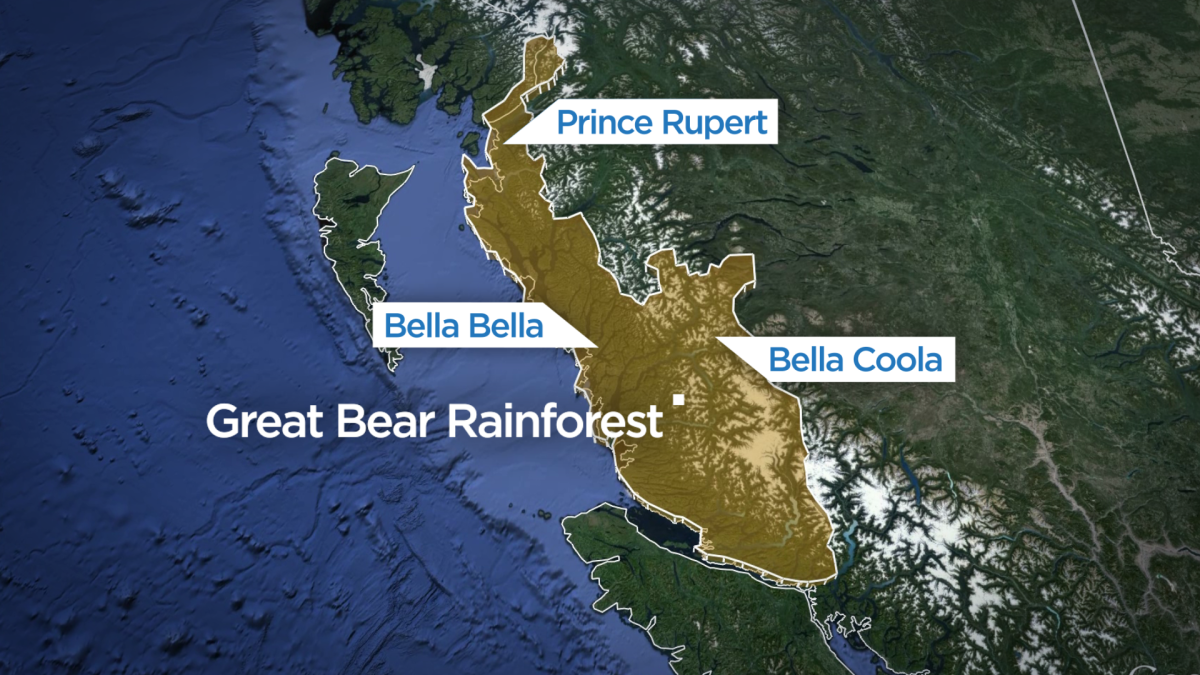The Great Bear Rainforest, about 700 kilometres northwest of Vancouver, runs along the central and north Pacific coast of British Columbia, stretching from the Discovery Islands northward to Alaska. It is the largest, intact temperate rainforest in the world.

Twenty-six B.C. First Nations claim traditional territory in the rainforest, reflecting the vested interest as they partnered with the B.C. government in an unprecedented “government-to-government” relationship.
Premier Christy Clark said understanding how to preserve and maintain the land’s sustainability is not possible without working with First Nations.
The Great Bear Rainforest covers an area of 6.4 million hectares. Just how big is this? Well, it makes up 7 per cent of the province, an area roughly the size of Ireland. Globally, rainforests make up 2 per cent of the earth and is home for an estimated 50 per cent of the earth’s plants and wildlife.
The new land-sharing deal announced today will now protect 85 per cent of the rainforest from logging while restricting it to just 15 per cent of the area.
The agreement also protects a sustainable habitat for five special interest species including mountain goats, grizzly bears, marbled murrelets, tailed frogs and northern goshawk.
The rainforest is known for the Kermode or Spirit Bear, an elusive subspecies of the black bear, recognized by its white fur and cultural connection to the First Nations people in the area.
A tourist destination for nature lovers and now a leader in global ecosystem management, there has been no shortage of activity (or controversy) – whether it’s forestry, wildlife studies or guided tours – in the Great Bear Rainforest.
A study in 2012 by the Centre of Responsible Travel revealed that revenue for bear watching expeditions was significantly higher than the controversial trophy hunting of bears in the rainforest.
Nine area First Nations have previously declared bans on bear hunting in their traditional territories but none were officially recognized by the B.C. government.
Protecting the interests of the Great Bear Rainforest has been a delicate balance of the struggle between man and nature and the centre of heated debates for years in B.C.
TIMELINE
1990s: War in the Woods: Activists and environmentalists protest the logging industry in the area.
2000: Forestry companies and environmental activists decide to put differences aside and work collaboratively through the Joint Solutions Project.
2006: The area was officially named the Great Bear Rainforest by then-premier Gordon Campbell in 2006. Environmentalists had given the area the name years before that in an effort to protect the central coast from logging. The province and First Nations commit to work together on land-based decisions and an ecosystem-based management plan to protect the Great Bear Rainforest
2009: B.C. government amends legal orders to protect 50 per cent of natural historic old growth forests; all participants agree to a five-year extension to implement ecosystem-based management.
2010-2011: B.C. government reaches reconciliation protocol agreements with Coastal First Nations and Nanwakolas Council.
Nov. 4, 2013: Pacific Wild Alliance fundraises to purchase two more live cameras in addition to the two that record wildlife like wolf pups catching salmon — it is hoped that “citizen science” will increase awareness of threats to the conservation area like pipeline proposals and tanker traffic.
Jan. 8, 2014: A CREST report from 2012 reveals that bear viewing generated more revenue than bear hunting in 2012. Bear viewing expenditures in 2012 generated $15.1 million in revenue compared to $1.2 million for guided non-resident and resident bear hunts combined.
The grizzly bear hunt is sustainable with 2 per cent of the population being harvested and it’s “not going to kill them all” — Scott Ellis, GOABC ED said.
Trophy hunting an iconic species is “barbaric behaviour” — Andrew Weaver, Green Party MLA Oak Bay-Gordon Head said.
READ MORE: WARNING (graphic content): Video showing grizzly bear getting shot multiple times during hunt sparks debate
Jan. 30, 2014: Environmental groups and forestry companies submit recommendations including increasing old-growth forest protection to 70 per cent and restricting an additional 500,000 hectares to logging companies.
May 21, 2015: TimberWest accused of “logging like crazy” months before new logging agreement to protect 70 per cent of the rainforest’s old growth from logging comes into effect.




Comments